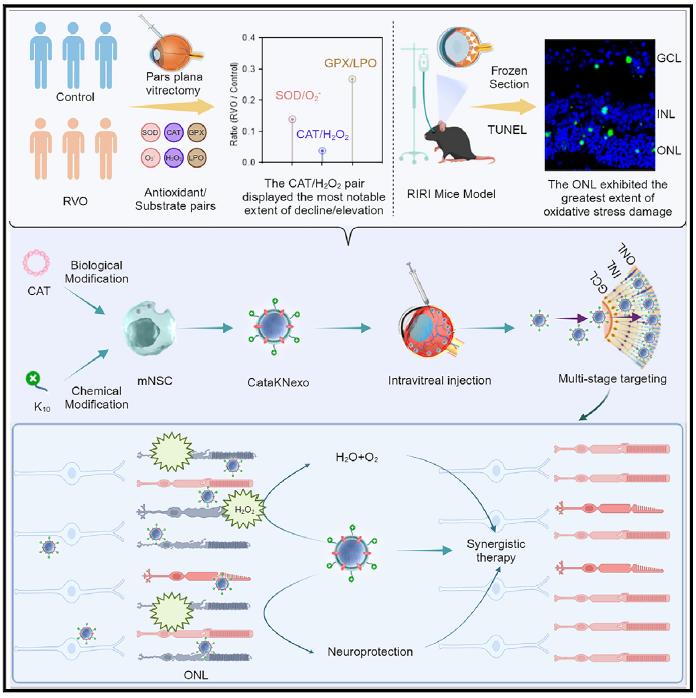CataKNeko - a reprogrammed neural stem cell extracellular vesicle
Retinal ischemia-reperfusion injury (RIRI), a common complication of conditions like retinal vein occlusion, leads to irreversible vision loss through oxidative damage. Current therapies, such as laser photocoagulation, fail to address the root cause—excessive ROS like H₂O₂. CataKNexo, a bioengineered exosome designed to deliver targeted antioxidant and neuroprotective therapy to the retina.

Clinical samples from RVO patients revealed diminished catalase activity and elevated H₂O₂, particularly in the ONL, where photoreceptor cells reside. This spatial specificity guided the design of CataKNexo. Neural stem cell-derived exosomes (Nexo) were chosen as a delivery platform due to their innate ability to home to retinal neurons and their cargo of neuroprotective miRNAs and proteins. To enhance therapeutic precision, Nexo were genetically modified to display CAT on their surface and chemically conjugated with K₁₀, a positively charged peptide that promotes transcytosis across retinal layers.
CataKNexo's dual modification enabled a two-stage targeting mechanism: initial retinal accumulation via CXCR4-SDF1 chemokine interactions, followed by K₁₀-mediated penetration into the ONL. In an innovative in vitro retinal model mimicking layered retinal structure, CataKNexo traversed ganglion and Müller cells to reach photoreceptor-like 661W cells, unlike unmodified exosomes. In vivo, intravitreal injections in RIRI mice showed prolonged retention (59-hour half-life) and significant reductions in H₂O₂ and apoptosis. Electroretinography confirmed restored visual function, with a-wave and b-wave amplitudes nearing normal levels.
Translational relevance was validated in Bama pigs, where CataKNexo alleviated retinal edema, preserved ONL thickness, and improved electrophysiological responses. Importantly, the therapy showed no systemic toxicity, addressing a critical hurdle for clinical adoption.
While promising, challenges remain. The reliance on NSC cell lines, rather than primary cells, raises concerns about phenotypic stability during scale-up. The authors propose mesenchymal stem cells as an alternative source. Additionally, optimizing mass production—via 3D culture systems or biogenesis enhancers like TSPAN6—will be crucial. Future studies could explore combining CataKNexo with anti-angiogenic agents (e.g., ranibizumab) for diabetic retinopathy or anti-inflammatory drugs for RVO-related edema.
By leveraging exosomes' natural tropism and enhancing them with catalytic and targeting moieties, CataKNexo offers a paradigm shift in treating RIRI. This approach not only addresses oxidative stress at its source but also paves the way for modular therapies adaptable to diverse retinal diseases. As the first study to validate such a strategy in large-animal models, it marks a significant step toward clinical translation, promising hope for millions affected by vision-threatening retinal disorders.
Reference
- Yang W, Wang X, Zheng D, Feng J, Kong W, Li Y, Ma G, Wei W, Tao Y. Catalytic neural stem cell exosomes for multi-stage targeting and synergistical therapy of retinal ischemia-reperfusion injury. Cell Rep Med. 2025 Apr 15;6(4):102052. doi: 10.1016/j.xcrm.2025.102052. PMID: 40239632.
Contact us or send an email at for project quotations and more detailed information.
Quick Links
-

Papers’ PMID to Obtain Coupon
Submit Now -

Refer Friends & New Lab Start-up Promotions

